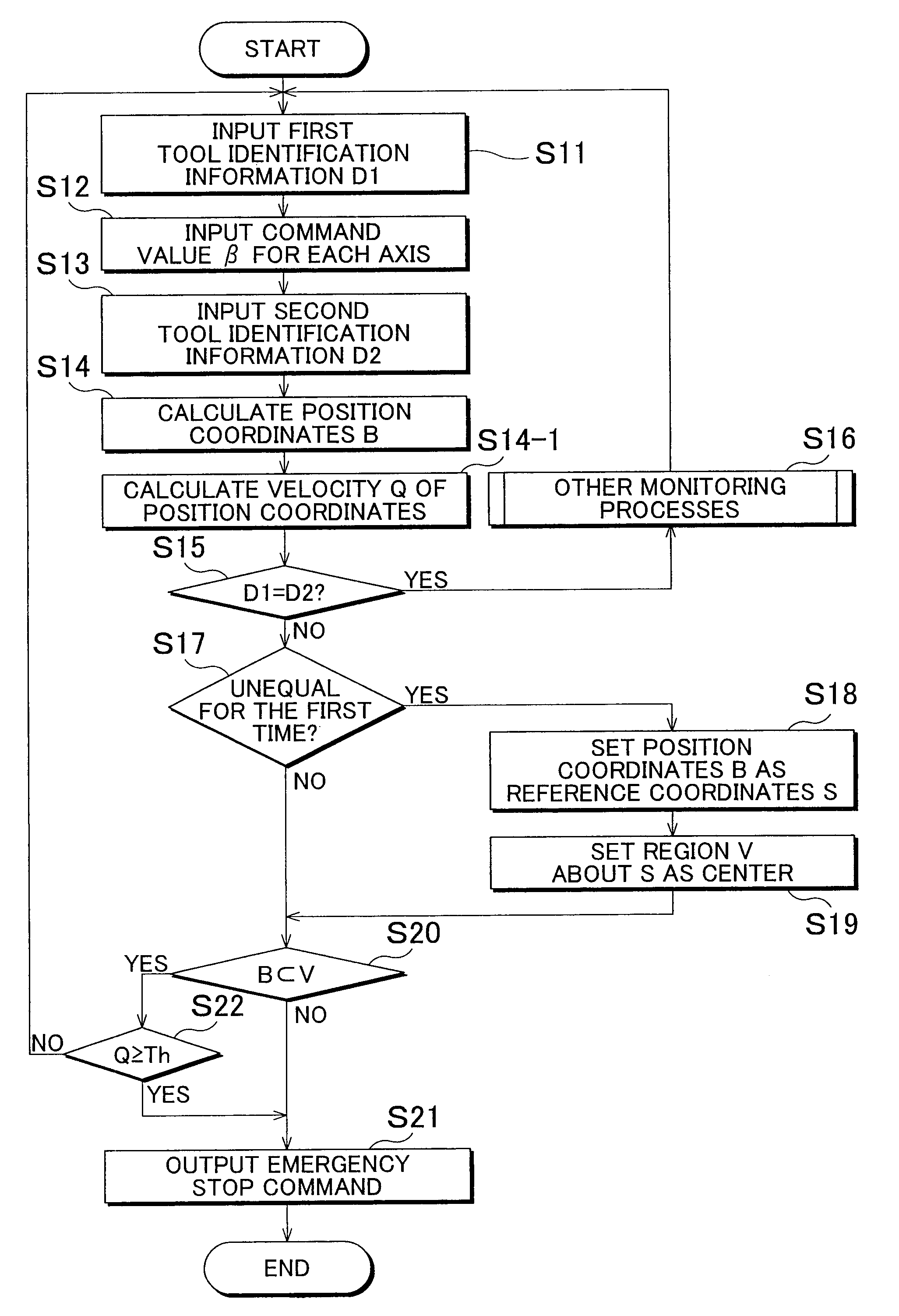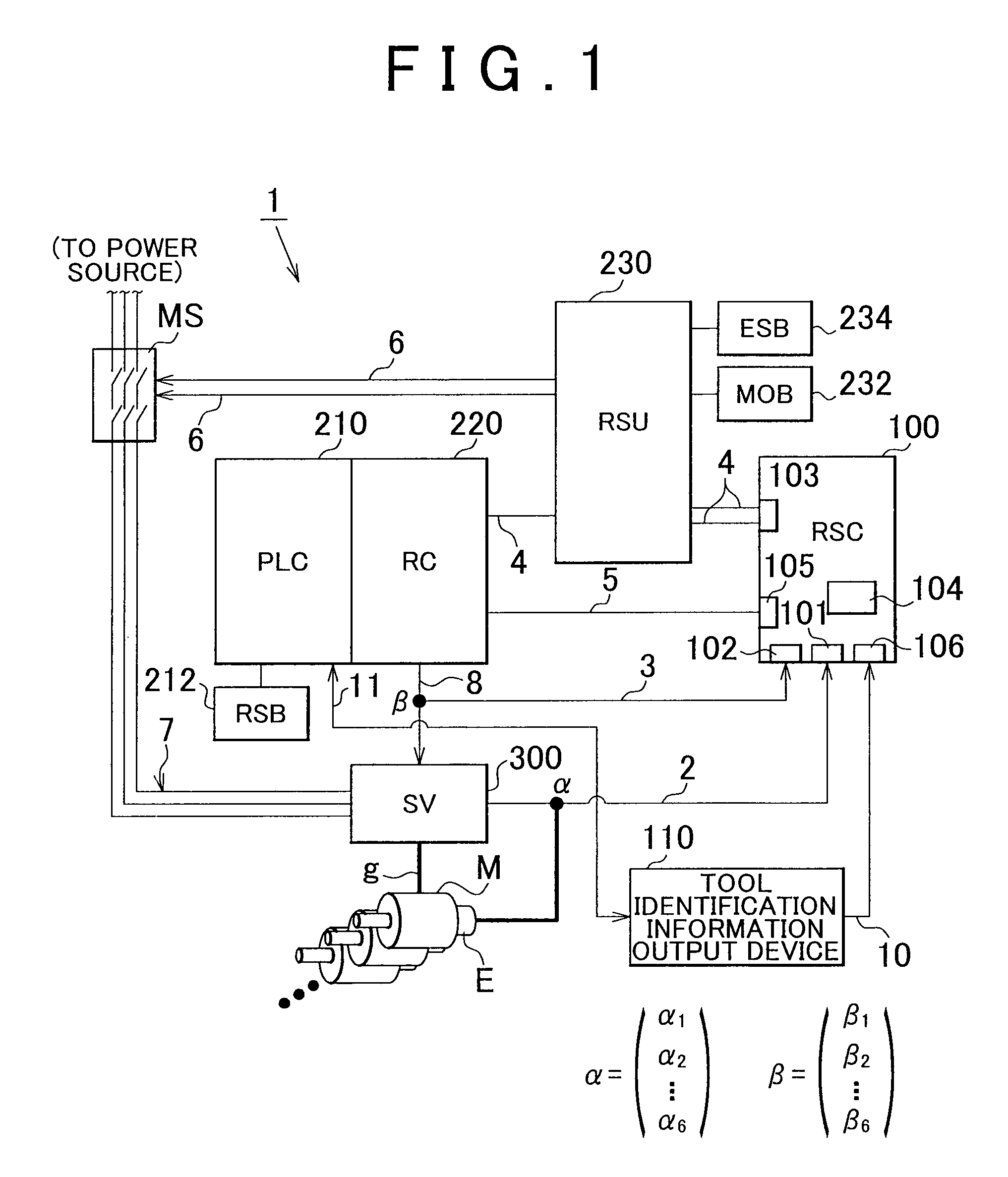Robot safety monitor device, and robot safety monitor method
a safety monitor and robot technology, applied in the direction of electrical programme control, program control, instruments, etc., can solve the problems of insufficient safety monitoring, natural differences, and no technology that improves safety in conjunction with the change of tools, so as to improve the safety of robots
- Summary
- Abstract
- Description
- Claims
- Application Information
AI Technical Summary
Benefits of technology
Problems solved by technology
Method used
Image
Examples
embodiment 1
[0030]FIG. 1 shows a main construction of a robot drive control system 1 of Embodiment 1. The robot drive control system 1 is constructed mainly of a robot safety unit (RSU, also termed a safety PLC) 230, a robot control device (robot controller (RC)) 220, a programmable logic controller (PLC) 210, a safety monitor device (robot safety controller (RSC)) 100, a servo unit 300, and a tool identification information output device 110. The robot control device 220, the robot safety unit 230, and the safety monitor device 100 are interconnected by a bus 4. Besides, the PLC 210 and the robot control device 220 are connected to each other by an internal bus. The robot control device 220 and the safety monitor device 100 are interconnected by a communication line 3 and a communication line 5. The robot control device 220 and the servo unit 300 are interconnected by a communication line 8. The servo unit 300 and the safety monitor device 100 are interconnected by a communication line 2. The ...
example 2
[0055]In Embodiment 1, a predetermined region is set by using, as a reference, the position coordinates of the taught reference point at the time when the two pieces of tool identification information become unequal to each other for the first time. Therefore, if the movement region of the taught reference point in the actual space is restricted in a time section in which two pieces of tool identification information are unequal regardless of at what position the tool change position is in the actual space, it is assumed that safety is secured even though the two pieces of tool identification information are unequal. In Embodiment 2, on the other hand, the tool change position in the actual space is known beforehand, and therefore the predetermined region V is not relatively determined with reference to the reference coordinates S, but is defined in absolute coordinates in the actual space. It suffices that if the predetermined region is one sphere, the center coordinates and the ra...
example 3
[0056]In Embodiments 1 and 2, no consideration is given to the moving velocity of the taught reference point during a period during which the two pieces of tool identification information are unequal. In Embodiment 3, the moving velocity of the taught reference point is further considered. A process procedure of the safety monitor device 100 as shown in FIG. 8 will be described. Steps S1 to S14 of the process procedure shown in FIG. 8 are substantially the same as those in Embodiment 1. In step S14-1, the moving velocity Q of the position coordinates B is computed from the position coordinates B computed in the past and the elapsed time. Step S15 to S20 of the process procedure in FIG. 8 are the same as those in Embodiment 1. In the case where the two pieces of tool identification information are unequal and the position coordinates S of the taught reference point exist in the predetermined region V, the answer to the determination in step S20 is YES, and subsequently it is determin...
PUM
 Login to View More
Login to View More Abstract
Description
Claims
Application Information
 Login to View More
Login to View More - R&D
- Intellectual Property
- Life Sciences
- Materials
- Tech Scout
- Unparalleled Data Quality
- Higher Quality Content
- 60% Fewer Hallucinations
Browse by: Latest US Patents, China's latest patents, Technical Efficacy Thesaurus, Application Domain, Technology Topic, Popular Technical Reports.
© 2025 PatSnap. All rights reserved.Legal|Privacy policy|Modern Slavery Act Transparency Statement|Sitemap|About US| Contact US: help@patsnap.com



